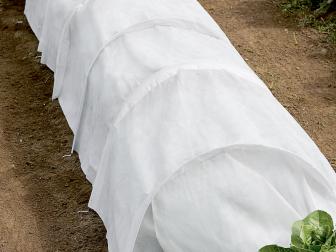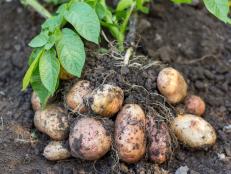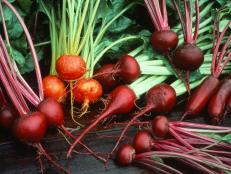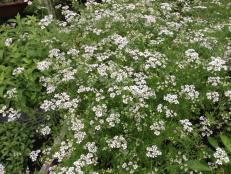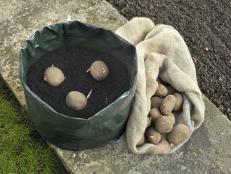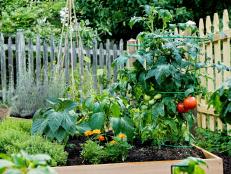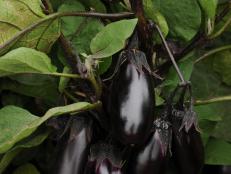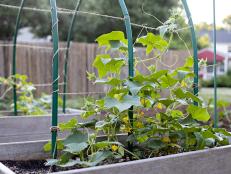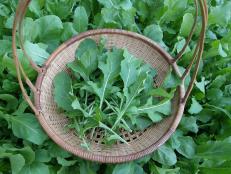Planting and Growing Radishes
Plan on growing radishes in spring and fall. Slice them into salads for a peppery punch, roast them to caramelize their flavors or eat them with salt, butter and a fresh baguette for a delicious snack.
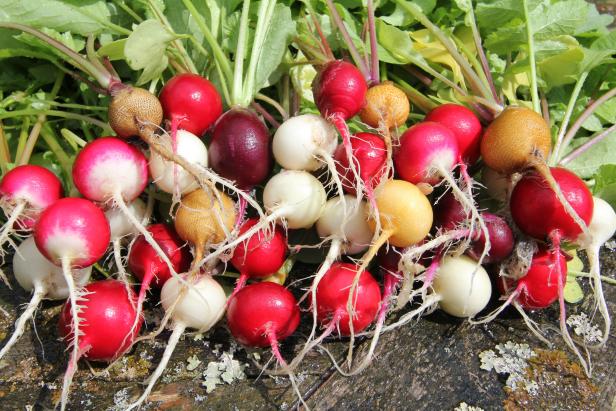
Andrew Spencer/Ball Horticultural Company
'Rainbow Mix' radish seeds produce a bright blend of red, white, yellow-gold and purple radishes with tangy white flesh.

Radishes might not be high on your list when you're planting a spring or fall garden, but don't overlook them. These humble veggies take up very little room and can be planted with other crops. Radish seedlings sprout fast, so they make great row markers, too. Chopped or sliced, radishes add crunch and flavor to pastas, salads and other dishes. You can even carve them into shapes to use as a garnish.
Choosing Which Radish Plant to Grow
If you think radishes (Raphanus sativus) are too pungent, maybe you haven't tried the right variety. There are plenty to choose from. These members of the Brassica family can taste spicy, sharp, earthy, sweet or mild. Radishes vary in shape from round to oblong and can have white, yellow, green red, rosy pink, reddish-purple or black skins. The inner flesh is usually white. For a mild flavor, choose a light or white variety.
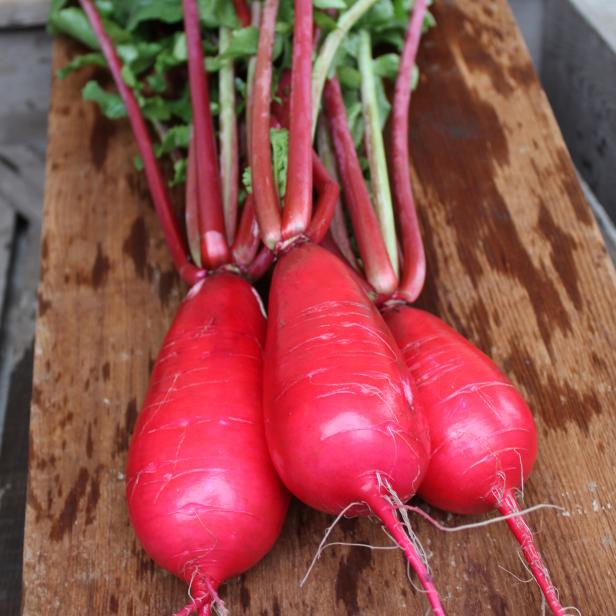
This crisp, juicy, Daikon-type radish, 'Red King,' takes 60 days to maturity. That's longer than most varieties.
Radishes with long roots need deep, loose soil. If your garden spot is less than ideal, you may want to plant your radish seeds in a raised bed or grow a round variety. Amy Enfield, with DTC Live Goods at The Scotts Miracle-Gro Company, shared more radish-raising tips with us.
Getting the Planting Site Ready
Choose a site that gets at least six hours of sun a day. Enfield says morning sun is ideal. Then, work your soil at least six to eight inches deep. Remove rocks, sticks and other debris.
16 Vegetables To Plant Now for Fall Harvest 16 Photos
Just as the summer garden gets in full swing, it's time to start thinking about fall. Here's a list of 16 vegetables you can plant in mid to late summer for a fall harvest.
Before planting radishes from seed, test the soil in your garden spot to see if you should add any amendments. Test kits are sold at garden centers and nurseries, or your local extension service office may be able to test a soil sample for you. Radish plants need well-drained, slightly acidic to neutral soil with a pH of 6.0 to 7.0.
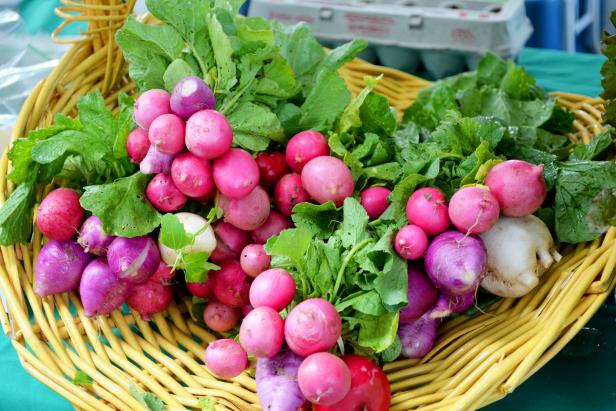
VisitWinstonSalem.com
If you don't like the peppery bite of most radishes, opt for a sweeter, milder variety like ‘Purple Plum’ or ‘Violet de Gournay.'
Add Organic Matter
Work in a few inches of well-rotted manure or compost before planting radishes, but avoid fresh manure that might introduce weed seeds and harmful bacteria. Also, mix in some all-purpose fertilizer, such as 10-10-10, as directed on the package. Water the soil until it's moist before sowing the seeds.
Planting Radishes
When Do Radishes Grow Best?
These root vegetables grow best before the weather heats up. Plant radishes from seeds in early spring, four to six weeks before the average date of your last spring frost. In fall, plant four to six weeks before the first expected fall frost. Radish seedlings usually take three to four days to sprout, but some varieties take a few weeks. Read your seed packet for more information.
Should I Start Radishes Indoors?
For best results, plant radish seeds directly in the garden. Transplanting disturbs their roots. There's not much reason to sow radish seeds indoors anyway since radish seedlings usually sprout fast and don't mind if the weather is cool.

Alexander Zatschkovitsch/Terra Organics/NGB
Grow 'Sango' radish for microgreens. The purple-green leaves can be used in slaws, salads and sandwiches and taste like radishes.
Planting Radishes in the Garden
There are two basic types of radishes: spring radishes and winter radishes. So-called spring radishes, like 'Crimson Giant' and 'Cherry Bomb,' are ready to harvest in less than a month, so they're best planted in early spring before the temperatures rise. Winter radishes like 'China Rose' can be planted in early fall. They take longer to mature but store better and can stay in the ground longer before you harvest them.
Sow radish seeds one inch apart in rows one foot apart in loosened soil. Cover them 1/2 to 1-inch deep and water them gently.
Keep planting radishes every ten days for a continuous harvest. One week after the radish seedlings appear, thin them to every two or three inches. For radish seedlings like Daikons, which will form bigger, longer roots, thin to every four to six inches.
Growing and Caring for Radish Plants
Water Consistently
If your radish plants don't get at least an inch of rainfall each week, water them deeply. Sandy soils may need watering more often.
Keep the soil around the radish plants moist but never let them sit in standing water. Periods of drought or inconsistent watering can make the roots tough, while too much water can make them split or crack. Radishes bolt, or set flowers, when they're allowed to get too dry, becoming so pungent that you won't want to eat them.
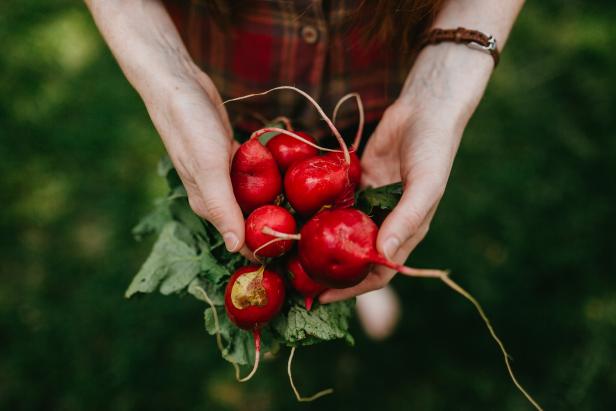
Scotts Miracle-Grow/FlashStock Technology Inc.
Red globe-type radishes are some of the easiest to grow, like 'Cherry Belle', says Amy Enfield of The Scotts Miracle-Gro Company.
Fertilize Once
Radishes aren't heavy feeders and they mature quickly, so work in an all-purpose fertilizer at planting time and don't fertilize again. If your soil is too rich, or your fertilizer is high in nitrogen, you'll wind up with more leaves than roots.
Weed Regularly
Weeds can crowd out radish plants. Pull any weeds or use a hoe to cultivate carefully around the radish plants as needed. Mulching with a thin layer of weed-free straw, untreated grass clippings or compost also helps control weeds and hold moisture in the soil.
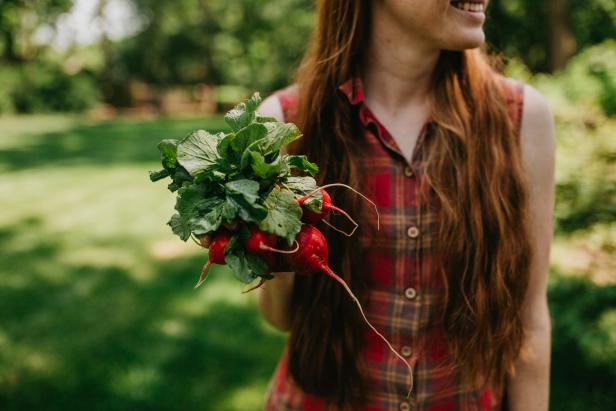
Scotts Miracle-Grow/FlashStock Technology Inc.
Thin radish seedlings so they don't get overcrowded or they may not form bulbs, says Amy Enfield of The Scotts Miracle-Gro Company. Also, leaving them in the ground too long can cause them to bolt.
Scout For Health Issues
It's not just gardeners who like radishes. Snails, slugs, aphids, flea beetles, cutworms, cabbage loopers and harlequin bugs will attack radish plants. Cabbage maggots can spread a disease called bacterial black spot to their roots.
Use floating fabric row covers to help keep pests off your radish plants. To prevent cutworms, use plant collars made from plastic cups or cardboard rolls. (It's also helpful to turn the soil thoroughly before planting your radish seeds to expose any cutworms to hungry birds.) Giving radish plants enough room to grow and good air circulation can also discourage pests and diseases.
Protect Plants With Row Covers
Learn how to properly use garden row covers to protect plants from insect pests and extreme weather conditions, including protection during winter.
To avoid destructive root maggots, rotate your radish plantings at least every three years and don't plant radish seeds where Brassica crops have previously grown. Working wood ashes into your planting soil may help deter root maggots, too.
Radishes are seldom bothered by diseases, but clubroot can distort or blacken the roots and cause radish plants to wilt, turn yellow and even die. This disease can be present even if you don't see any symptoms above ground. Once this pathogen is in the soil, your best bet is to rotate radish crops and other members of the cabbage family and clean and disinfect any garden tools you've used on them. Infected radish plants should be completely removed and discarded in the trash.
Companion Plants for Radishes
Radish plants are great helpers in the garden. They'll draw pests like flea beetles and aphids away from squash, peppers and other vegetables. Plant plenty of radish seeds if you plan to "sacrifice" some of your radish harvest to these pests.
Otherwise, good radish companion plants include lettuces, tomatoes, carrots, onions, peppers, peas, cucumbers and spinach as well as herbs like dill, mint and oregano. The radishes will mature before most other crops and help break up the soil as they grow.
When to Harvest Radishes
There are several ways to know when to harvest radishes. Check your seed packet for the approximate number of days to maturity or pull up a couple of radish plants and sample the roots. They should be crunchy and crispy. Radishes left in the ground too long turn pithy and hot. Still not sure when to harvest radishes? Brush some soil away from the top of a couple of roots. You'll know when to harvest the radishes when the roots are about an inch in diameter at the soil's surface.
When they're ready, pull up your radish plants. If the ground is hard, use a garden fork or trowel to gently loosen it.
How to Store Radishes
Cut off the radish tops and tail roots, wash and dry the radishes, and store them in plastic bags in the refrigerator. Wash, dry and store the greens separately for up to three days. You can also freeze unpeeled radishes, although freezing changes their texture. For better results, blanch them first.
Radish Recipes from Food Network
Try some of Food Network's best radish recipes.







